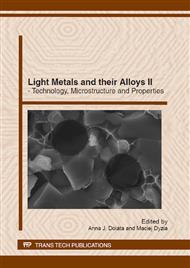[1]
H. Friedrich, S. Schumann, Research for a "new age of magnesium" in the automotive industry, Journal of Materials Processing Technology. 117 (2001) 276÷281.
DOI: 10.1016/s0924-0136(01)00780-4
Google Scholar
[2]
R. Kawalla, Magnesium and magnesium alloys Monograph edited by Hadasik E., Manufactured of metals. Plasticity and structure. Silesian University and Technology, Gliwice, 2006.
Google Scholar
[3]
B. L. Mordike, T. Ebert, Magnesium Properties - applications – potential, Materials Science and Engineering. A302 (2001) 37÷45.
Google Scholar
[4]
J. Bohlen, D. Letzig K. Kainer U, New Perspectives for Wrought Magnesium Alloys, Materials Science Forum. 546-549 (2007) 1÷10.
DOI: 10.4028/www.scientific.net/msf.546-549.1
Google Scholar
[5]
E. Hadasik., D. Kuc, G. Niewielski, R. Śliwa, Development of magnesium alloys for plastic working, Hutnik - Wiadomości Hutnicze 76. 8 (2009) 666÷670.
Google Scholar
[6]
B. Jiang , J. Wang, P Ding, Ch Yang, Rolling of AZ31 Magnesium Alloy Thin Strip Materials Science Forum. 546-549 (2007) 365÷368.
DOI: 10.4028/www.scientific.net/msf.546-549.365
Google Scholar
[7]
H. Somekawa, Dislocation creep behaviour in Mg-Al-Zn alloys, Materials Science and Engineering A. 407(2005) 53÷61.
DOI: 10.1016/j.msea.2005.06.059
Google Scholar
[8]
M. M. Myshlyaev, H. J. McQueen, E. Konopleva, Microstructural development in Mg alloy AZ31 during hot working, Materials Science and Engineering A337 (2002) 121÷127.
DOI: 10.1016/s1359-6462(97)00344-8
Google Scholar
[9]
D. Kuc , E. Hadasik, G. , A. Płachta, Structure and plasticity of the AZ31 magnesium alloy after hot deformation, Journal of Achievements in Materials and Manufacturing Engineering 27(2008) 27÷31.
Google Scholar
[10]
D. Kuc, E. Hadasik, A. Szuła, Research of plasticity and microstructure of magnesium alloys AZ31 type in die – casting and hot rolling condition after deformation, Hutnik - Wiadomości Hutnicze, 76. 8 (2009) 666÷670.
Google Scholar
[11]
L.A. Dobrzański, T. Tanski, L. Cizek, J. Madejski, The influence of the heat treatment on the microstructure and properties of Mg-Al-Zn based alloys, Archives of Materials Science and Engineering. 36/1 (2009) 48÷54.
Google Scholar
[12]
I. Schindler J. Boruta, Determinig and using of activation energy for hot working processes, Archives of Metalurgy 4. (1994) 471÷491.
Google Scholar


